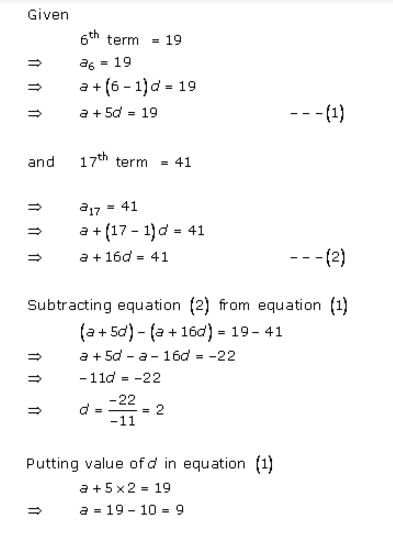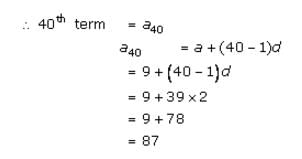Quant Exam > Quant Questions > The 7thand 21stterms of an AP are 6 and -22 r...
Start Learning for Free
The 7th and 21st terms of an AP are 6 and -22 respectively. Find the 26th term.
- a)-34
- b)-32
- c)12
- d)-10
- e)-16
Correct answer is option 'B'. Can you explain this answer?
Verified Answer
The 7thand 21stterms of an AP are 6 and -22 respectively. Find the 26t...
Method to Solve :


Most Upvoted Answer
The 7thand 21stterms of an AP are 6 and -22 respectively. Find the 26t...
To find the 26th term of an arithmetic progression (AP), we need to use the formula for the nth term of an AP.
The formula for the nth term of an AP is given by:
an = a + (n-1)d
Where:
an = nth term
a = first term
n = position of the term
d = common difference
We are given:
a7 = 6
a21 = -22
Step 1: Finding the Common Difference (d)
Using the formula, we can find the common difference (d) by subtracting the 7th term from the 21st term:
d = a21 - a7
d = -22 - 6
d = -28
Step 2: Finding the First Term (a)
Using the formula and substituting the values we have for the 7th term and the common difference, we can solve for the first term (a):
a7 = a + (7-1)d
6 = a + 6d
Substituting the value of d:
6 = a + 6(-28)
6 = a - 168
a = 6 + 168
a = 174
Step 3: Finding the 26th Term (a26)
Using the formula and substituting the values we have for the first term and the common difference, we can solve for the 26th term (a26):
a26 = a + (26-1)d
a26 = 174 + 25(-28)
a26 = 174 - 700
a26 = -526
Therefore, the 26th term of the arithmetic progression is -526. However, none of the given options match this answer. So, it seems there might be a mistake in the options provided.
The formula for the nth term of an AP is given by:
an = a + (n-1)d
Where:
an = nth term
a = first term
n = position of the term
d = common difference
We are given:
a7 = 6
a21 = -22
Step 1: Finding the Common Difference (d)
Using the formula, we can find the common difference (d) by subtracting the 7th term from the 21st term:
d = a21 - a7
d = -22 - 6
d = -28
Step 2: Finding the First Term (a)
Using the formula and substituting the values we have for the 7th term and the common difference, we can solve for the first term (a):
a7 = a + (7-1)d
6 = a + 6d
Substituting the value of d:
6 = a + 6(-28)
6 = a - 168
a = 6 + 168
a = 174
Step 3: Finding the 26th Term (a26)
Using the formula and substituting the values we have for the first term and the common difference, we can solve for the 26th term (a26):
a26 = a + (26-1)d
a26 = 174 + 25(-28)
a26 = 174 - 700
a26 = -526
Therefore, the 26th term of the arithmetic progression is -526. However, none of the given options match this answer. So, it seems there might be a mistake in the options provided.
Free Test
FREE
| Start Free Test |
Community Answer
The 7thand 21stterms of an AP are 6 and -22 respectively. Find the 26t...
7th term = 6
21st term = -22
That means, 14 times common difference or -28 is added to 6 to get -22
Thus, d = -2
7st term = 6 = a+6d
⇒ a + (6*-2) = 6
⇒ a = 18
26st term = a + 25d
⇒ 18 - 25*2 = -32.
21st term = -22
That means, 14 times common difference or -28 is added to 6 to get -22
Thus, d = -2
7st term = 6 = a+6d
⇒ a + (6*-2) = 6
⇒ a = 18
26st term = a + 25d
⇒ 18 - 25*2 = -32.

|
Explore Courses for Quant exam
|

|
Similar Quant Doubts
The 7thand 21stterms of an AP are 6 and -22 respectively. Find the 26thterm.a)-34b)-32c)12d)-10e)-16Correct answer is option 'B'. Can you explain this answer?
Question Description
The 7thand 21stterms of an AP are 6 and -22 respectively. Find the 26thterm.a)-34b)-32c)12d)-10e)-16Correct answer is option 'B'. Can you explain this answer? for Quant 2025 is part of Quant preparation. The Question and answers have been prepared according to the Quant exam syllabus. Information about The 7thand 21stterms of an AP are 6 and -22 respectively. Find the 26thterm.a)-34b)-32c)12d)-10e)-16Correct answer is option 'B'. Can you explain this answer? covers all topics & solutions for Quant 2025 Exam. Find important definitions, questions, meanings, examples, exercises and tests below for The 7thand 21stterms of an AP are 6 and -22 respectively. Find the 26thterm.a)-34b)-32c)12d)-10e)-16Correct answer is option 'B'. Can you explain this answer?.
The 7thand 21stterms of an AP are 6 and -22 respectively. Find the 26thterm.a)-34b)-32c)12d)-10e)-16Correct answer is option 'B'. Can you explain this answer? for Quant 2025 is part of Quant preparation. The Question and answers have been prepared according to the Quant exam syllabus. Information about The 7thand 21stterms of an AP are 6 and -22 respectively. Find the 26thterm.a)-34b)-32c)12d)-10e)-16Correct answer is option 'B'. Can you explain this answer? covers all topics & solutions for Quant 2025 Exam. Find important definitions, questions, meanings, examples, exercises and tests below for The 7thand 21stterms of an AP are 6 and -22 respectively. Find the 26thterm.a)-34b)-32c)12d)-10e)-16Correct answer is option 'B'. Can you explain this answer?.
Solutions for The 7thand 21stterms of an AP are 6 and -22 respectively. Find the 26thterm.a)-34b)-32c)12d)-10e)-16Correct answer is option 'B'. Can you explain this answer? in English & in Hindi are available as part of our courses for Quant.
Download more important topics, notes, lectures and mock test series for Quant Exam by signing up for free.
Here you can find the meaning of The 7thand 21stterms of an AP are 6 and -22 respectively. Find the 26thterm.a)-34b)-32c)12d)-10e)-16Correct answer is option 'B'. Can you explain this answer? defined & explained in the simplest way possible. Besides giving the explanation of
The 7thand 21stterms of an AP are 6 and -22 respectively. Find the 26thterm.a)-34b)-32c)12d)-10e)-16Correct answer is option 'B'. Can you explain this answer?, a detailed solution for The 7thand 21stterms of an AP are 6 and -22 respectively. Find the 26thterm.a)-34b)-32c)12d)-10e)-16Correct answer is option 'B'. Can you explain this answer? has been provided alongside types of The 7thand 21stterms of an AP are 6 and -22 respectively. Find the 26thterm.a)-34b)-32c)12d)-10e)-16Correct answer is option 'B'. Can you explain this answer? theory, EduRev gives you an
ample number of questions to practice The 7thand 21stterms of an AP are 6 and -22 respectively. Find the 26thterm.a)-34b)-32c)12d)-10e)-16Correct answer is option 'B'. Can you explain this answer? tests, examples and also practice Quant tests.

|
Explore Courses for Quant exam
|

|
Signup for Free!
Signup to see your scores go up within 7 days! Learn & Practice with 1000+ FREE Notes, Videos & Tests.





















